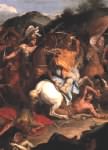
Biography
Battle of Issus
Battle of Issus Chart
Conquest of Persia
Lunar Eclipse
Battle of Gaugamela
Battle of Gaugamela Chart
The Antichrist
Death
Death Chart
Conclusion
Planets
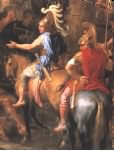 Alexander
the Great was tutored by Aristotle to the age of 16. He was also
trained as a soldier. He became King of Macedon in 336 BC at age
20 when his father Philip II was assassinated. He was a skilled warrior
and military genius, and he was destined to fight a great battle to become
the ruler of the world. As such, even though he was an Evil King,
he was a type of the Lord Jesus Christ at the Second Advent.
Alexander
the Great was tutored by Aristotle to the age of 16. He was also
trained as a soldier. He became King of Macedon in 336 BC at age
20 when his father Philip II was assassinated. He was a skilled warrior
and military genius, and he was destined to fight a great battle to become
the ruler of the world. As such, even though he was an Evil King,
he was a type of the Lord Jesus Christ at the Second Advent.
After becoming king, Alexander quickly set out to build an empire and conquered Asia Minor from Persia. He continued his conquests in Syria and Egypt. Through his conquests Greek culture was spread all over the world. The city of Alexandria in Egypt is named for him.
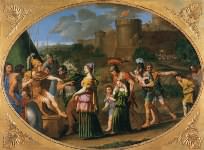
Alexander was destined to become
the ruler of the world. He was symbolized by the belly of bronze
of the great statue in Nebuchadnezzar's
dream. In a great victory he routed the Persians under King Darius
III at Issus in 333 BC.
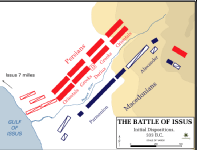 |
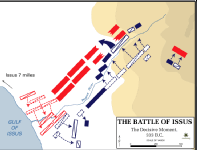 |
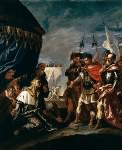 The
Persian cavalry began the battle by crossing the river and attacking Paermenion.
Alexander led foot soldiers against the Persian infantry (the Cardaces)
and broke through the Persian line. He then mounted a cavalry charge
at Darius, who fled the battle. Rather than pursue Darius, Alexander
had to come to the aid of his army. He attacked the rear of the Persian
army, which quickly fled once they saw their King was gone. Alexander's
army pursued the Persians and killed them until dark.
The
Persian cavalry began the battle by crossing the river and attacking Paermenion.
Alexander led foot soldiers against the Persian infantry (the Cardaces)
and broke through the Persian line. He then mounted a cavalry charge
at Darius, who fled the battle. Rather than pursue Darius, Alexander
had to come to the aid of his army. He attacked the rear of the Persian
army, which quickly fled once they saw their King was gone. Alexander's
army pursued the Persians and killed them until dark.
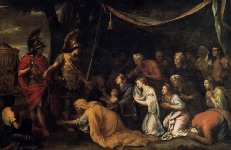 After
Darius fled, Alexander captured his wife, mother, and two daughters.
He later married one of the daughters, Stateira II, and the mother of Darius
became like a mother to Alexander. It was the first time the Persians
were defeated under the leadership of King Darius III. This great
victory set the stage for Alexander to conquer Persia and become the ruler
of the world as predicted by Nebuchadnezzar's dream.
After
Darius fled, Alexander captured his wife, mother, and two daughters.
He later married one of the daughters, Stateira II, and the mother of Darius
became like a mother to Alexander. It was the first time the Persians
were defeated under the leadership of King Darius III. This great
victory set the stage for Alexander to conquer Persia and become the ruler
of the world as predicted by Nebuchadnezzar's dream.
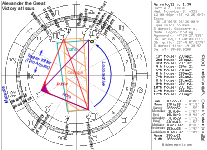 The
Chart of the Battle of Issus contains a Horn, a Plow, a Coffin, a Catwalk,
a Teeter-Totter, and a Locomotive. A Horn is the symbol of power.
The Horn pointed to the Almighty God Planet in Libra for the Supreme Court
of Heaven. The power of the Lord Jesus Christ on His Throne determined
the outcome of the battle. A Plow symbolizes intense suffering like
being plowed under. A Coffin is for burying the dead. And a
Catwalk symbolizes a narrow bridge. The Catwalk corresponded to the
Pinarus River and to the mountain passes, including the Beilan Pass, Pillar
of Jonah, and Amanic Gates. There was also a gap that Alexander was
able to cross over because it was filled with the dead bodies of Persians.
The Teeter-Totter formed by planets on two sides of the Chart corresponds
to the two opposing armies. And the Locomotive symbolizes a strategic
advance to the Morning Star in Libra for cataclysmic judgment, corresponding
to the great Battle of Issus.
The
Chart of the Battle of Issus contains a Horn, a Plow, a Coffin, a Catwalk,
a Teeter-Totter, and a Locomotive. A Horn is the symbol of power.
The Horn pointed to the Almighty God Planet in Libra for the Supreme Court
of Heaven. The power of the Lord Jesus Christ on His Throne determined
the outcome of the battle. A Plow symbolizes intense suffering like
being plowed under. A Coffin is for burying the dead. And a
Catwalk symbolizes a narrow bridge. The Catwalk corresponded to the
Pinarus River and to the mountain passes, including the Beilan Pass, Pillar
of Jonah, and Amanic Gates. There was also a gap that Alexander was
able to cross over because it was filled with the dead bodies of Persians.
The Teeter-Totter formed by planets on two sides of the Chart corresponds
to the two opposing armies. And the Locomotive symbolizes a strategic
advance to the Morning Star in Libra for cataclysmic judgment, corresponding
to the great Battle of Issus.
The Plow pointed to the God of the Covenants in Aquarius for the bearer of good news. The good news was the victory that would propel Alexander toward his destiny as foretold by Nebuchadnezzar's dream. Aquarius corresponds to the location of Greece. The Plow also symbolizes Alexander plowing through the enemy lines of the Persians.
There were three planets in both Scorpius and Libra, which gives extra significance to these signs in the Chart. Scorpius denotes the influence of Satan and evil, whereas Libra signifies the Judgment of God.
The Sun was in Scorpius for Satan who appears as an angel of light. Satan empowered both kings. The other planets in Scorpius were:
The planets in Libra were:
The Last Adam was in Taurus for hidden power. Alexander had hidden power because he was God's chosen one to be King of the world.
 The
epic battle of human history was foretold by a Lunar Eclipse on September
20, 331 BC on the autumnal equinox. The Babylonian astrologers kept
careful records of the eclipse which have been preserved for history.
They saw the eclipse as a terrible omen of doom.
The
epic battle of human history was foretold by a Lunar Eclipse on September
20, 331 BC on the autumnal equinox. The Babylonian astrologers kept
careful records of the eclipse which have been preserved for history.
They saw the eclipse as a terrible omen of doom.
The eclipse began when the Moon rose in the East about 40 minutes before the Almighty God Planet set in the West. The wind was from the West at the beginning of the eclipse and shifted to the East toward the end. Since the Magians of Persia believed the Moon was a sign of Persia, which was in the East compared to Macedon, and the Macedon Army was approaching from the West, this was a very bad omen. Actually the Moon could symbolize the nation in some cases, but the meaning was a little different here. The Moon was in conjunction with the God of the Covenants in Pisces, which had the following meaning:
The Almighty God Planet and Redeemer were in conjunction on the Descendant.
The Bottom of Heaven was in Leo for death of a nation, corresponding to the defeat of the Persian Empire. Also in Leo was the Morning Star for King of kings, corresponding to Darius III, who was the existing sovereign King of the world who was about to be deposed. This was symbolized by a Plow pointing to the Morning Star for intense suffering like being plowed under. Darius III would be defeated and flee for his life.
The Chart of the eclipse contained a Plow, a Trumpet, a Rectangle, a Teeter-Totter, and a Locomotive. The narrow Rectangle symbolized the battlefield as well as the phalanxes of troops arrayed on it. The Plow cut across the battlefield to symbolize Alexander's cavalry plowing through the enemy lines of Darius. And the Trumpet was the herald of triumph in conquering the world. The Teeter-Totter symbolizes the opposition of the two armies of Alexander and Darius. The Locomotive, which symbolizes strategic advance, pointed to the God of the Covenants in Pisces for the fulfillment of the mystery doctrine of Nebuchadnezzar's dream. History would occur as Daniel had foretold through the interpretation of Nebuchadnezzar's dream of a statue with a stomach of bronze, corresponding to Alexander the Great. The three pairs of planets in the Chart symbolizes a flood, corresponding to the flood of troops across the battlefield due to the large armies fighting.
The Mediator Planet was in Aries
for a founder, corresponding to Alexander as the founder of a new world
empire.
 |
 |
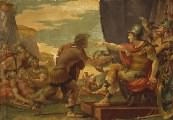
On the morning of September 23 a meteor was seen. This was an harbinger of a significant event approaching. Later that day a captive from the Battle of Issus arrived with news that the wife of Darius had died in childbirth, and Alexander had buried her.
Darius was anxious to avoid another battle with Alexander. On September 24 Darius sent a peace proposal to Alexander. Darius offered Alexander all of the land West of the Euphrates and one of his daughters in marriage. However, Alexander refused.
On the evenings of September 25 and 26, the Babylonian astrologers saw a "fall of fire," which is interpreted to mean a meteor or comet.7 The Macedonians saw this also, and it caused a panic. Assuming these were meteors, they were harbingers. However, the Babylonians would have seen them as signs of the anger of the gods caused by conjunctions of planets. At any rate, Alexander became very circumspect. The Macedonians did not break camp from the 26th to 28th. They moved out on the 29th and were in battle formation on the far side of the field on the 30th. Darius noticed that the formation was similar to the formation in the Battle of Issus. Alexander could see the Persian line that stretched 3.5 miles (6 km).
The night of September 30 was the day the Persians celebrated the beginning of Autumn with the festival of Mithrakana with sacrifices to Mithra, the Sun, and the holy fire. Mithra was the god of light. On the other hand Alexander worshipped Zeus and considered himself to be the son of Zeus and Ammon. Darius worshipped Mithra, and Alexander considered himself a god. However, there is a high power who determines sovereign rulers, and that is God. Nebuchadnezzar had to learn that lesson the hard way. Alexander never learned it. He thought he was a god. Nevertheless, God had already decided to support Alexander, as revealed through Nebuchadnezzar's dream.
In addition to the two armies of men on the battlefield, there were two armies of angels, Elect and Fallen. The Elect Angels of God were empowered to protect Alexander and his army and oppose Darius and his army. God had already determined the outcome. However, the men were allowed to make their own decisions and fight their own battles even though there were events beyond their control.
Darius made his troops stand in battle formation all night on September 30th for fear of a night attack by Alexander. Darius was in the center of the Persian battle line with his royal squadron. He was flanked on both sides by Greek mercenaries, who were the only ones capable of fighting against the Macedonian phalanx. Indian elephants (believed to be 15) were out front along with scythed chariots, which were equipped with sharp extensions of their axels for slicing into the enemy infantry. On the right was the Babylonian cavalry of Mazaeus along with Armenian and Cappadocian cavalry. On the left was the Sacaean cavalry commanded by Bessius.
Alexander's troops were deployed similar to the deployment in the Battle of Issus. The phalanx was in the center with another behind it in reserve to handle any contingencies. Parmenion was in command of the left and Alexander the right. Parmenion must hold the left flank long enough to enable Alexander with the cavalry to breach the enemy lines to the right. Peltists ran along to the right of the cavalry to guard it from a flanking counterattack of the enemy. Alexander's plan was to ride to the right and look for an opening in the enemy line to exploit. He would attempt to plow through the line.
The Battle of Gaugamela occurred on October 1, 331 BC. Very little is known about the actual battle. Some things can be assumed and others deduced, but the only contemporary record of the battle is preserved on a Babylonian clay tablet of the Astronomical Diaries. It says that Alexander won and became "king of the world," and Darius suffered a heavy defeat. After Darius' troops abandoned him and went home, he and some others in his army fled to lands in the east.
On the morning of the twenty-fourth of the month of Ul?lu, the king of the world [Alexander] raised his standard [lacuna]. The armies engaged each other and the king's soldiers suffered a heavy defeat. The troops abandoned their king [Darius] and headed back to their cities. They fled to the lands in the east. [Astronomical Diaries, -330, obv.15-18]13The volumes that have been written about the battle are attempts to explain what happened hundreds of years later. What is known is that the two armies clashed in a plain full of dust where it would be difficult to see much of anything. No one had a grandstand view. Alexander probably plowed into the enemy line and gained the upper hand over the unseasoned conscripts of Darius who turned and ran. When Darius was forced to flee, most of the others probably also fled. At some point the Babylonian cavalry of Mazaeus broke through the Macedonian line and plundered the Macedonian camp rather than attack the Macedonian rear.
Alexander did not catch Darius when he fled. Perhaps Alexander stayed and fought or went to aid Parmenion. The elephants were basically useless. They were easily distracted with spears. But they were symbols of Baal and a giant, corresponding to the demon support of Darius in Spiritual Warfare. And the chariots were a miserable failure because the Macedonians had perfected a simple defense against them. When the chariots attacked, the soldiers formed a pocket into which the horses would go where they would be easy targets for javelins.
Alexander's army was composed of
well-trained, seasoned veterans who believed in him. However, the
army of Darius was full of draftees who had never seen combat. When
Alexander began to kill them, they broke ranks and ran. Darius used
a bureaucratic approach. He fielded a large army of diverse groups,
which made communication difficult. He had superior numbers, but
his troops were untrained, untested, and they had no incentive to fight.
They were men without a country. Alexander's troops were well trained,
rested, and battle hardened. Though outnumbered, they were a cohesive,
courageous fighting force.
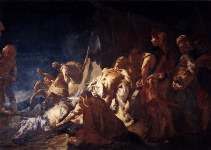
Alexander led his troops into battle
and instilled in them the fighting spirit. He had the noble simplicity
characteristic of heroes. He was a genuine example for his men.
In spite of his backstabbing generals, he convinced them to work as a team
to achieve victory. Darius was a weak, incompetent general who used
others to protect his own power. His tactics were a reaction to fear.
He crafted bureaucratic solutions. Deep down inside he was a phony
who was overly concerned with external appearance to cover up his weakness.
His men were not loyal to him. He was murdered the next year by his
own officials, Nabarzanes and Barsaentes, to save their skin as Alexander
was approaching. They fled and left him to die in the same way as
the troops of Darius had left him on the battlefield of Gaugamela.
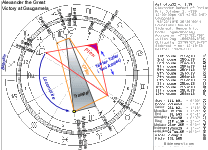 The
Chart of the Battle of Gaugamela contains a Plow, a Coffin, a Trumpet,
a Teeter-Totter, and a Locomotive. The Plow symbolizes intensive
suffering, like being plowed under. It corresponds to Alexander's
cavalry plowing into the Persian lines. A Coffin is for burying the
dead. A Trumpet is for signaling judgment and heralding victory.
The Teeter-Totter symbolized the two armies in opposition on the battlefield.
And the Locomotive symbolized strategic advance to the God of the Covenants
in Pisces for mystery doctrine, corresponding to Nebuchadnezzar's dream
as interpreted by Daniel. Alexander was the stomach of bronze of
the statue in the dream.
The
Chart of the Battle of Gaugamela contains a Plow, a Coffin, a Trumpet,
a Teeter-Totter, and a Locomotive. The Plow symbolizes intensive
suffering, like being plowed under. It corresponds to Alexander's
cavalry plowing into the Persian lines. A Coffin is for burying the
dead. A Trumpet is for signaling judgment and heralding victory.
The Teeter-Totter symbolized the two armies in opposition on the battlefield.
And the Locomotive symbolized strategic advance to the God of the Covenants
in Pisces for mystery doctrine, corresponding to Nebuchadnezzar's dream
as interpreted by Daniel. Alexander was the stomach of bronze of
the statue in the dream.
The Coffin and the Trumpet were centered along the axis between Libra and Aries for the opposition of Divine Judgment and leadership. The Sun was in Libra in conjunction with the Red Planet. The Savior Planet was also in Libra. These planets symbolized:
The Plow resolved the opposition between the Redeemer and Almighty God in Scorpius and the Last Adam in Taurus into the Moon in Leo. The Plow pointed to the Moon to symbolize the judgment upon the ruling nation of Persia. The meaning of the other planets of the Plow was:

The celebrations at Susa included drinking, dancing, and forced marriages to Persians. The princesses of Persia had received a Greek education since Alexander's conquest in 331 BC. They were married to Alexander's officers. Alexander married two of them, and Hephaestion married Drypetis, a daughter of Darius III. All of the marriages except one ended in divorce. Alexander also made appointments of men to serve in his royal court and gave them royal titles. Alexander bestowed upon himself the royal title of "lord of all."9
Alexander introduced the Persian custom of proskynesis in his royal court. This was a customary greeting in which those of equal rank kissed on the mouth. If one was inferior, they kissed on the cheeks. And one of much less noble rank would fall down and worship the other.
A corps of 30,000 Bactrians (from northern Afghanistan) arrived to join Alexander's phalanx. And Iranians were allowed to join Alexander's Companion cavalry, which had recently suffered heavy casualties. The parochial Macedonians, however, did not readily accept the infusion of their army with foreign fighters. The cultural conflict soon led to mutiny.
When Alexander left with his army and reached Opis on the way to Babylon, he gave his veterans the option of returning home with a handsome retirement. However, they concluded that he didn't need them anymore because they had been replaced with Persians. Since Alexander saw himself as a god, they told him he could fight his wars with his own father, the god Ammon. Alexander called their bluff and transferred their duties to the foreigners. In the end they backed down and apologized.
Alexander threw a lavish banquet with 9,000 guests to celebrate the reconciliation. In the seating arrangement, Alexander was in the center with his close friends and commanders. The Macedonians sat in an inner circle around them. The Persians sat in an outer circle. On the periphery were others, such as Phoenicians, Egyptians, Babylonians, and Indians. During the banquet, Alexander offered a prayer for harmony and partnership in rule between the Macedonians and Persians.
The partnership in rule meant that the Macedonians would be administrators and the Iranians would populate Alexander's army. He would appoint Macedonians as satraps. Over 10,000 veterans were retired and sent home. Alexander found out that the Macedonians were grieved because they were not considered kinsmen like some of the Persians and therefore not allowed to kiss him. Alexander henceforth gave all the Macedonians the title of 'Kinsmen' and allowed them to kiss him.
The cultural diversity crisis in Alexander's empire was the result of the Tower of Babel. After breaking down the Tower of Babel, God instituted nationalism and different languages to protect the freedom of individual ethnic groups. Satan was trying to rule the world at Babel. As soon as Alexander became world ruler, Satan used him. The marriages to the Persian princesses were the infiltration of the Prostitute of Babylon. The infiltration of foreign troops into Alexander's army was from Satan as the god of chaos inspiring the Evil King. The cultural diversity (such as speaking different languages) that God instituted at the Tower of Babel hinders integration of an empire. Foreigners do not have vested interest in the empire. Like Darius before him, Alexander was forced to manage chaos in cultural diversity.
Alexander proclaimed himself 'lord of all,' a sovereign title of the Antichrist bestowed by Satan. Jesus Christ is "Lord of all" (Acts 10:36; Rom 10:12). Alexander's new title was an attempt by Satan to demonstrate his ability to rule the world prior to the Millennium when the Lord Jesus Christ will rule as Lord of all.
At the beginning of 323 BC Alexander gave orders to the Greek world to worship him as god. Although this was not without precedent among the Greeks, it was another sign of the Antichrist.
Alexander altered his route. He stopped at the Euphrates River the first day, and the next day he kept the Euphrates on his right. In one account he even camped 36 kilometers away and sent his delegation into the city ahead of him. However, after being unable to find an alternate route into the city without bogging down in the swamp, he went ahead and entered the city.8, 10
The Chaldeans were told by Bel through Satan that Alexander would die. Satan knew because he was about to administer the Sin Leading to Death to Alexander. The astrologers combined the knowledge received from demons with the configuration of the heavens. They may have keyed off the upcoming Lunar Eclipse of April 28, which would occur as the Almighty God Planet set. That had occurred in the eclipse before Darius was defeated. They considered the Almighty God Planet their king.
In May 323 BC, the Babylonian astrologers were so afraid that Alexander was going to die that they put a proxy king on Alexander's throne during his absence. This was one of their common beliefs that the proxy would die in the place of the real king.
Later a delegation returned from the shrine of Ammon in Siwa. After the death of his friend Hephaestion, Alexander had sent them to inquire as to what kind of burial his friend should receive. The delegation returned with the answer that Zeus Ammon permitted Hephaestion to be a demi-god (heros). Alexander celebrated the good news with a drinking party. After the party, he met with his friend Medius of Larisa and had more wine.
The next morning Alexander was ill and carried on his duties from his bed. In the following days his health deteriorated. He had high fever, and he became weaker daily. According to the Babylonian Astronomical Diaries, Alexander died on June 11, 323 BC in his 14th year as King. Further, the Macedonian Royal Diaries report his death at evening (3 to 6 PM).11 Although Alexander's birth date is not known with certainty, he died at age 32 about a month short of his 33rd birthday.
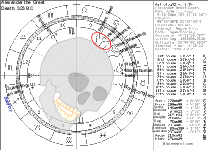 The
Chart of the death of Alexander the Great contains a Skull. A Skull
is a morbid symbol of death at the hand of Satan, who has the power of
death. He is allowed to execute the Sin
Leading to Death with God's permission. A Stellium of three planets
were in Cancer, which gives significance to the sign in the Chart.
The
Chart of the death of Alexander the Great contains a Skull. A Skull
is a morbid symbol of death at the hand of Satan, who has the power of
death. He is allowed to execute the Sin
Leading to Death with God's permission. A Stellium of three planets
were in Cancer, which gives significance to the sign in the Chart.
The Red Planet was in Virgo for a bloody son, corresponding to the suffering of Alexander's death.
Alexander was an antichrist. He was under demon power from an early age. As the world ruler, he was the Antichrist. He was so full of Satan that it was impossible to distinguish Satan from the man. Alexander called himself a god and 'lord of all.' It wasn't enough for Alexander to be the ruler of all. He wanted to be worshipped by all as lord. This is a sign of the Antichrist (Rev 13:4, 8).
At the beginning of 323 BC Alexander ordered the Greek world to worship him as god. Six months later on June 11, 323 BC he died the Sin Leading to Death. He had become the Antichrist and was Satan's alternative to the Lord Jesus Christ. As Satan, who lived in him, Alexander challenged the rule of Heaven and wanted to be worshipped as god. This was Alexander expressing his negative volition to God to the maximum. After he had unequivocally rejected Salvation, he was delivered over to dying punishment of the Sin Leading to Death. He remained with Satan to the end, and Satan was happy to have him as a witness in Hell.
![]()
![]()
Released September 27, 2014 - Revised Feb. 15, 2015
| Beginning | Author | Comments | Home |